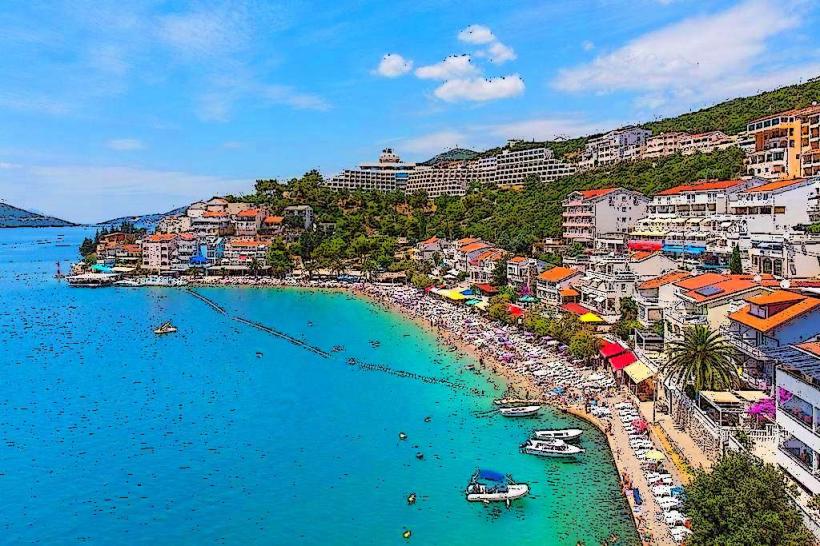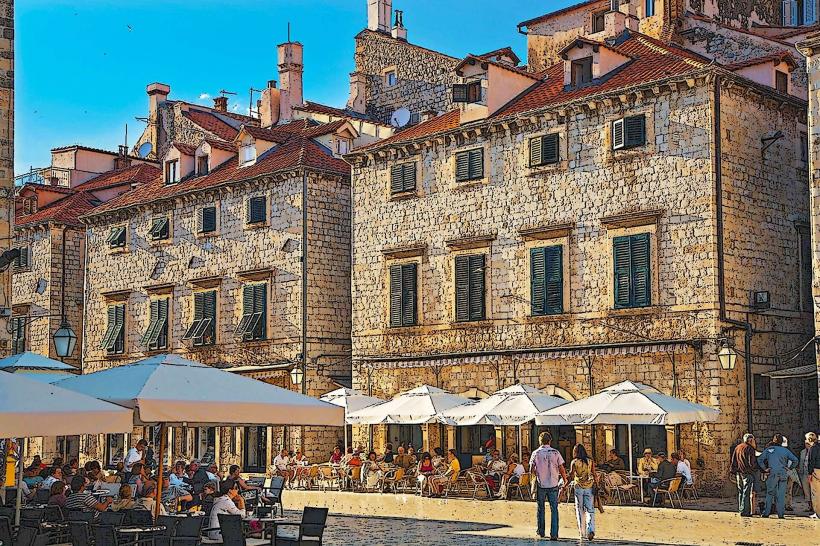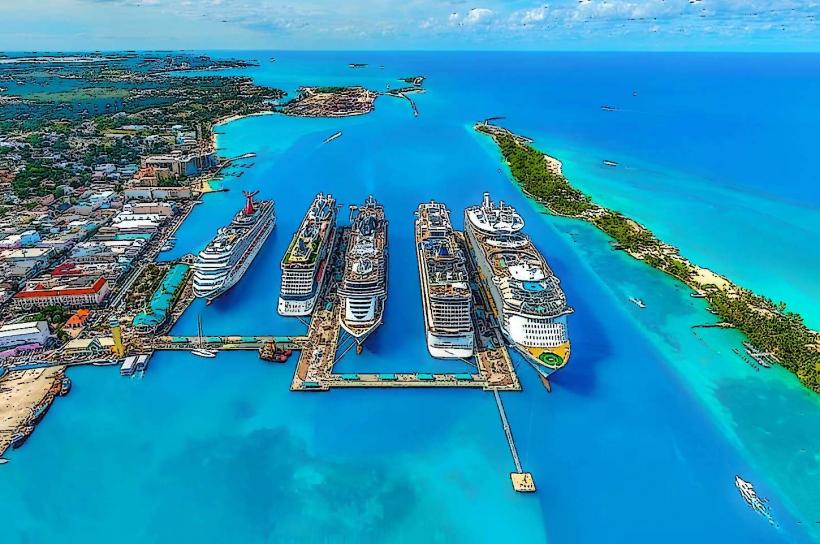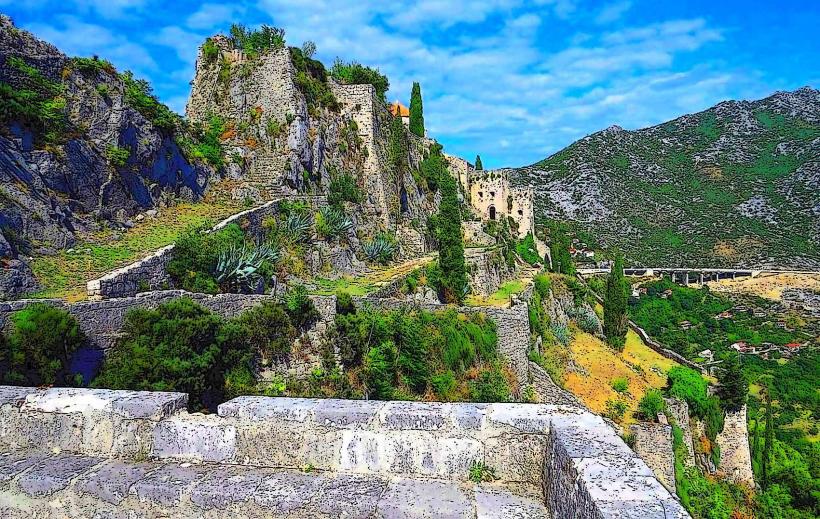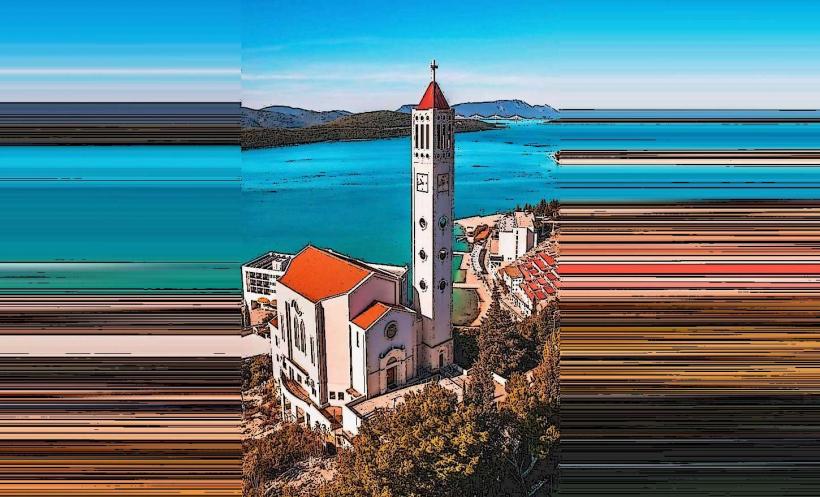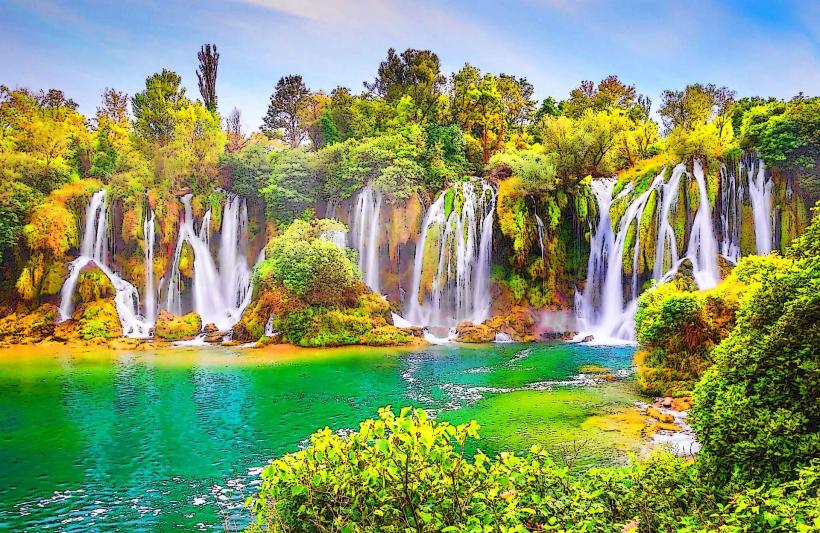Information
City: NeumCountry: Bosnia and Herzegovina
Continent: Europe
Neum is the only coastal town in Bosnia and Herzegovina, situated along the Adriatic Sea. It is located in the southernmost part of the country, within the Herzegovina-Neretva Canton of the Federation of Bosnia and Herzegovina entity. As a small but historically significant town, Neum has a unique geographic and cultural position as Bosnia and Herzegovina’s only outlet to the sea.
Geography and Climate
Neum is located on the southern coast of the Adriatic Sea, nestled between the Croatian coastline to the north and the Pelješac Peninsula to the south. The town is part of the Neretva River delta region, with rolling hills surrounding it on the landward side. The town's small but picturesque coastline stretches for about 24 kilometers (15 miles), with beautiful beaches and clear waters.
Neum enjoys a Mediterranean climate, with hot, dry summers and mild, wet winters. Summer temperatures regularly exceed 30°C (86°F), making it a popular summer tourist destination, while winter temperatures rarely drop below freezing. The area is often bathed in sunshine, and the warm Adriatic Sea influences the town’s mild weather year-round.
History
Neum's history dates back to the Roman period, but it rose to greater significance during the Middle Ages. The town's strategic position on the Adriatic made it an important point of trade, and throughout history, it has been ruled by various empires and states.
Roman and Medieval History: The region surrounding Neum has evidence of early settlements dating back to Roman times. The area was once part of the Roman province of Dalmatia. Neum’s significance grew during the Middle Ages when it was part of the Republic of Dubrovnik (Ragusa), which controlled trade routes along the Adriatic Sea.
Ottoman Period (1463–1878): Neum was incorporated into the Ottoman Empire in the late 15th century. Under Ottoman rule, Neum developed as a coastal settlement, although it remained relatively small compared to other towns in the region. The Ottomans used the area for maritime trade and also as a strategic military location. During this period, Neum began to develop its coastal economy, including fishing and salt production, which were important to the local economy.
Austro-Hungarian Period (1878–1918): Following the Congress of Berlin in 1878, Neum became part of the Austro-Hungarian Empire. Under Austro-Hungarian rule, Neum’s infrastructure was improved, and it saw some urbanization. The Austro-Hungarians also constructed roads and port facilities, which helped integrate Neum into the wider region.
Yugoslav Period (1918–1992): After World War I, Neum became part of the newly formed Kingdom of Yugoslavia and later the Socialist Federal Republic of Yugoslavia. During the 20th century, Neum remained a small but important town due to its position as Bosnia and Herzegovina’s only coastal settlement. Neum’s strategic location became even more significant in the latter half of the century, especially during the Yugoslav Wars of the 1990s.
Bosnian War (1992–1995): During the Bosnian War, Neum remained under the control of the Bosnian government forces, although the surrounding region was heavily affected by the war. Neum was spared much of the physical destruction seen in other parts of Bosnia and Herzegovina, largely due to its remote location and strategic importance. The town continued to serve as an outlet to the Adriatic, and after the war, Neum became a symbol of Bosnia and Herzegovina’s connection to the sea.
Culture and People
Neum has a population that is predominantly Croatian in ethnicity, with most residents identifying as Roman Catholic. However, as part of Bosnia and Herzegovina, it also has a multi-ethnic and multi-religious history, which is characteristic of the broader cultural landscape of the country.
Religion and Architecture: The majority of the population in Neum practices Catholicism, and there are several churches in the town, with the Church of St. Anthony of Padua being one of the most notable. The architecture in Neum is primarily Mediterranean in style, reflecting the town’s Dalmatian heritage, with narrow streets, white stone buildings, and coastal influences.
Cuisine: Neum’s cuisine is heavily influenced by Mediterranean and Dalmatian traditions, with seafood playing a central role in the local diet. Grilled fish, octopus, and shellfish are common dishes, and fresh herbs like rosemary and oregano are used frequently. Other traditional Bosnian dishes such as ćevapi (grilled minced meat) and burek (pastry filled with meat or cheese) are also popular in Neum. Olive oil, wine, and cheese are other key components of the local cuisine.
Arts and Festivals: Although Neum is relatively small, it hosts several cultural and music events throughout the year, particularly during the summer months. Neum Summer, an annual event, celebrates the town’s coastal culture with concerts, festivals, and local performances. The town also has cultural exhibitions and art galleries, though it is primarily known as a beach resort rather than a cultural hub.
Languages: The primary language spoken in Neum is Croatian, which is the official language of the town. However, Bosnian and Serbian are also widely understood, reflecting the multicultural nature of the region.
Economy and Development
The economy of Neum has historically been centered around its position as a coastal town. The town benefits from its location as the only Bosnian outlet to the Adriatic Sea, and this has made it an important hub for tourism, fishing, and maritime trade.
Tourism: Tourism is the backbone of Neum’s economy. With its Mediterranean climate, clean beaches, and clear waters, Neum attracts visitors from across Bosnia and Herzegovina, as well as international tourists, particularly from neighboring Croatia. Neum is a popular summer resort, with numerous hotels, restaurants, and beachfront accommodations catering to visitors. The town’s long coastline offers opportunities for swimming, boating, and water sports, while the surrounding hills are popular for hiking.
The town has benefited from its unique position, as it is less developed than other Adriatic destinations such as Dubrovnik or Split, offering a more relaxed atmosphere for visitors. Neum has also become a popular destination for family vacations, due to its quieter and more affordable accommodations compared to the more bustling coastal cities.
Fishing and Maritime Economy: Historically, Neum has relied on fishing and maritime trade. The town’s fishing industry provides fresh seafood, which is a staple of the local diet. Neum also has a small port for commercial and recreational boats, contributing to its maritime economy.
Retail and Services: Over the years, Neum has developed a service economy focused on tourism and retail. The town has various shops, cafes, and restaurants that cater to both locals and tourists. In recent years, the real estate sector has also seen growth, as more people are looking to invest in properties along the Adriatic coast.
Transportation
Neum is well-connected to the rest of Bosnia and Herzegovina and neighboring regions through its road network.
Roads: The town is situated along the M2 highway, which connects Neum to other parts of Bosnia and Herzegovina, as well as neighboring Croatia. The town is about 60 km (37 miles) from Mostar and approximately 140 km (87 miles) from Dubrovnik, Croatia. Visitors from Croatia can easily drive into Neum, though they must pass through a border crossing due to the town’s location within Bosnia and Herzegovina’s territorial enclave.
Airports: Neum does not have its own airport, but it is easily accessible from several major airports in the region. The closest airport is Dubrovnik Airport in Croatia, which is about an hour's drive away. The Mostar Airport and Sarajevo International Airport are also viable options for those traveling to Neum by air.
Conclusion
Neum is a unique and picturesque town that offers Bosnia and Herzegovina its only access to the Adriatic Sea. With its Mediterranean climate, charming coastal landscape, and rich cultural history, Neum is a significant hub for tourism, fishing, and local trade. While it may be small, its strategic location and relaxed atmosphere make it a popular and essential destination for both locals and visitors from abroad.

